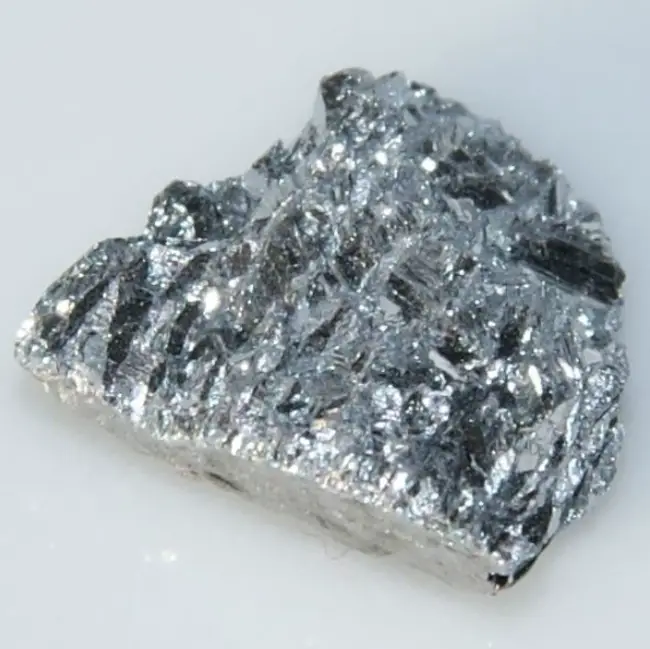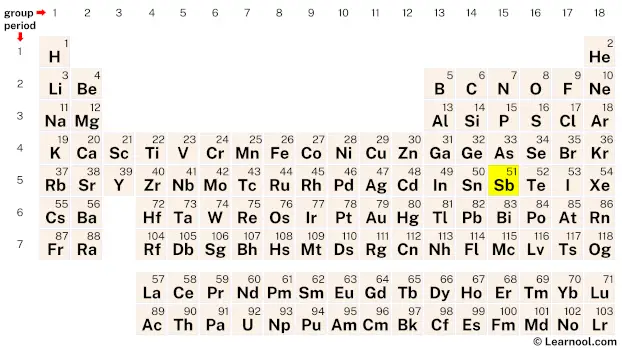
Antimony (Sb) is a chemical element of the periodic table, located in the group 15 and the period 5, and is having the atomic number 51. It is a hard, brittle, lustrous, silvery-grey metalloid, whose name comes from the Greek word “anti-monos”, which means not alone. It is a member of the pnictogen group.
On periodic table
| group | ⇨ | 1 | 2 | 3 | 4 | 5 | 6 | 7 | 8 | 9 | 10 | 11 | 12 | 13 | 14 | 15 | 16 | 17 | 18 |
| period | ⇩ | ||||||||||||||||||
| 1 | 1 H  Hydrogen |
2 He  Helium |
|||||||||||||||||
| 2 | 3 Li  Lithium |
4 Be  Beryllium |
5 B  Boron |
6 C  Carbon |
7 N  Nitrogen |
8 O  Oxygen |
9 F  Fluorine |
10 Ne  Neon |
|||||||||||
| 3 | 11 Na  Sodium |
12 Mg  Magnesium |
13 Al  Aluminium |
14 Si Silicon |
15 P  Phosphorus |
16 S  Sulfur |
17 Cl  Chlorine |
18 Ar  Argon |
|||||||||||
| 4 | 19 K  Potassium |
20 Ca  Calcium |
21 Sc  Scandium |
22 Ti  Titanium |
23 V  Vanadium |
24 Cr  Chromium |
25 Mn  Manganese |
26 Fe  Iron |
27 Co  Cobalt |
28 Ni  Nickel |
29 Cu  Copper |
30 Zn  Zinc |
31 Ga  Gallium |
32 Ge  Germanium |
33 As  Arsenic |
34 Se  Selenium |
35 Br  Bromine |
36 Kr  Krypton |
|
| 5 | 37 Rb  Rubidium |
38 Sr  Strontium |
39 Y  Yttrium |
40 Zr  Zirconium |
41 Nb  Niobium |
42 Mo  Molybdenum |
43 Tc  Technetium |
44 Ru  Ruthenium |
45 Rh  Rhodium |
46 Pd  Palladium |
47 Ag  Silver |
48 Cd  Cadmium |
49 In  Indium |
50 Sn  Tin |
51 Sb Antimony |
52 Te  Tellurium |
53 I  Iodine |
54 Xe  Xenon |
|
| 6 | 55 Cs  Caesium |
56 Ba  Barium |
72 Hf  Hafnium |
73 Ta  Tantalum |
74 W  Tungsten |
75 Re  Rhenium |
76 Os  Osmium |
77 Ir  Iridium |
78 Pt  Platinum |
79 Au  Gold |
80 Hg  Mercury |
81 Tl  Thallium |
82 Pb  Lead |
83 Bi  Bismuth |
84 Po  Polonium |
85 At  Astatine |
86 Rn  Radon |
||
| 7 | 87 Fr  Francium |
88 Ra  Radium |
104 Rf  Rutherfordium |
105 Db  Dubnium |
106 Sg  Seaborgium |
107 Bh  Bohrium |
108 Hs  Hassium |
109 Mt  Meitnerium |
110 Ds  Darmstadtium |
111 Rg  Roentgenium |
112 Cn  Copernicium |
113 Nh  Nihonium |
114 Fl  Flerovium |
115 Mc  Moscovium |
116 Lv  Livermorium |
117 Ts  Tennessine |
118 Og  Oganesson |
||
| 57 La  Lanthanum |
58 Ce  Cerium |
59 Pr  Praseodymium |
60 Nd  Neodymium |
61 Pm  Promethium |
62 Sm  Samarium |
63 Eu  Europium |
64 Gd  Gadolinium |
65 Tb  Terbium |
66 Dy  Dysprosium |
67 Ho  Holmium |
68 Er  Erbium |
69 Tm  Thulium |
70 Yb  Ytterbium |
71 Lu  Lutetium |
|||||
| 89 Ac  Actinium |
90 Th  Thorium |
91 Pa  Protactinium |
92 U  Uranium |
93 Np  Neptunium |
94 Pu  Plutonium |
95 Am  Americium |
96 Cm  Curium |
97 Bk  Berkelium |
98 Cf  Californium |
99 Es  Einsteinium |
100 Fm  Fermium |
101 Md  Mendelevium |
102 No  Nobelium |
103 Lr  Lawrencium |
|||||
| – p block |
Antimony is a p-block element, situated in the fifteenth column and the fifth row of the periodic table, denoted by the atomic number 51 and chemical symbol Sb.
Element information
 |
|
 |
|
| Origin of name | Greek word “anti-monos” (which means not alone) |
| Symbol | Sb |
| Atomic number (Z) | 51 |
| Atomic mass | 121.76 u |
| Block | p-block |
| Group | 15 (nitrogen group) |
| Period | 5 |
| Classification | Metalloid |
| Atomic radius | 140 pm |
| Covalent radius | 139±5 pm |
| Van der Waals radius | 206 pm |
| Melting point | 630.63 ℃, 1167.13 ℉, 903.78 K |
| Boiling point | 1635 ℃, 2975 ℉, 1908 K |
| Electron configuration | [Kr] 4d10 5s2 5p3 |
| Learn how to write: Antimony electron configuration | |
| Electrons per shell | 2, 8, 18, 18, 5 |
| Learn how to draw: Antimony Bohr model | |
| Crystal structure | Rhombohedral |
| Phase at r.t | Solid |
| Density near r.t | 6.697 g/cm3 |
| Main isotopes | Antimony-121, Antimony-123 |
| Natural occurrence | Primordial |
| Oxidation state | -3, +3, +5 |
| Electronegativity (Pauling scale) | 2.05 |
| Protons Neutrons Electrons |
51 71 51 |
| Valence electrons | 5 |
| Learn how to find: Antimony valence electrons | |
| CAS number | 7440-36-0 |
| Discovered by | Arabic alchemists before AD 815 |
History
Antimony has a rich history dating back to ancient times. The name antimony is believed to have been derived from the Greek word “anti” meaning “not” and “monos” meaning “alone” because antimony was often found with other metals. The element has been known since ancient times and was used in various applications, such as makeup and medicinal treatments. The ancient Egyptians and Babylonians used antimony sulfide as a cosmetic, and it was also used in the Middle Ages to treat various ailments such as malaria and skin diseases. In the 17th century, antimony was used as a component in alloys for casting bells and cannons.
Occurrence
Antimony is a relatively abundant element in the Earth’s crust, with an estimated abundance of 0.2 to 0.5 parts per million. It is primarily found in the form of sulfide minerals, such as stibnite (Sb2S3), which is the most common mineral form of antimony. Antimony is also found in small quantities in other minerals, such as valentinite (Sb2O3) and senarmontite (Sb2O3).
Production
Antimony is typically produced from stibnite ore (Sb2S3), which is processed into antimony metal and antimony oxide (Sb2O3). The extraction of antimony from stibnite involves a series of pyrometallurgical and hydrometallurgical processes. In the pyrometallurgical process, stibnite ore is first heated in a furnace with air, which converts it to antimony oxide. The antimony oxide is then reduced with coke to produce antimony metal. In the hydrometallurgical process, stibnite ore is dissolved in hot sodium hydroxide, which produces a solution of sodium antimonate. The sodium antimonate is then acidified to produce antimony trioxide.
Antimony production is concentrated in a few countries, with China being the largest producer, accounting for around 78% of global antimony production. Other major producers include Russia, Tajikistan, and Bolivia.
Properties
Antimony is a silvery-white, brittle metalloid that has a metallic luster.
It has a relatively low melting point of 630 ℃, but it has a high boiling point of 1635 ℃.
Antimony is a poor conductor of heat and electricity.
It is highly reactive and can react with acids, oxygen, halogens, and other nonmetals.
Antimony has three allotropes: yellow, black, and metallic. The metallic form is the most stable at room temperature and pressure.
It has a high density of 6.697 grams per cubic centimeter.
Antimony can form compounds with a wide variety of elements, including sulfur, carbon, and halogens.
Applications
Antimony trioxide is widely used as a flame retardant in plastics, textiles, and building materials. It works by releasing water when exposed to fire, which helps to suppress flames.
Antimony is used in lead-acid batteries as an alloying agent to increase the durability and strength of the lead.
Antimony is used in the production of semiconductors, including diodes, infrared detectors, and Hall-effect devices.
Antimony is used as an alloying element with lead and tin to produce low-friction and wear-resistant bearings, as well as in bullets and shot for hunting and shooting.
Antimony is used in the production of glass as a fining agent, which helps to remove bubbles and improve clarity.
Antimony compounds are used in the production of a range of pigments, including orange, yellow, and red pigments.
Antimony has been used in traditional medicine for thousands of years to treat a range of conditions, including parasitic infections and skin diseases. However, it is no longer used in modern medicine due to its toxicity.
Antimony is also used in the production of ceramics, enamelware, and as a catalyst in the production of polyester resins.
Interesting facts
The name “antimony” comes from the Greek words “anti” and “monos”, meaning “not alone”. This refers to antimony’s tendency to form compounds with other elements rather than existing in its pure form.
Antimony has been used since ancient times, with evidence of antimony being used in cosmetics and medicines in ancient Egypt dating back to around 3100 BC.
Antimony is a toxic element, and historically, its compounds were used as poisons.
Antimony has a number of interesting physical properties. For example, it expands as it solidifies, making it difficult to cast into molds. It is also a poor conductor of heat and electricity.
Antimony is used in the production of lead-acid batteries, which are commonly used in automobiles. It is added to the lead plates in the battery to improve their hardness and durability.
Antimony is also used in the production of flame-retardant materials, such as those used in plastics and textiles. This is because antimony compounds release water vapor when heated, which can help to suppress flames.
Antimony has unique isotopes, one of which decays into tellurium, making it useful in nuclear reactors to regulate fission reactions.
Related
More elements
External links
- https://en.wikipedia.org/wiki/Antimony
- https://www.rsc.org/periodic-table/element/51/antimony
- https://www.britannica.com/science/antimony
- https://education.jlab.org/itselemental/ele051.html
- https://pubchem.ncbi.nlm.nih.gov/element/Antimony
- https://www.chemicool.com/elements/antimony.html
- https://chemistrytalk.org/antimony-element/
- https://www.livescience.com/37390-antimony.html
Deep
Learnool.com was founded by Deep Rana, who is a mechanical engineer by profession and a blogger by passion. He has a good conceptual knowledge on different educational topics and he provides the same on this website. He loves to learn something new everyday and believes that the best utilization of free time is developing a new skill.
